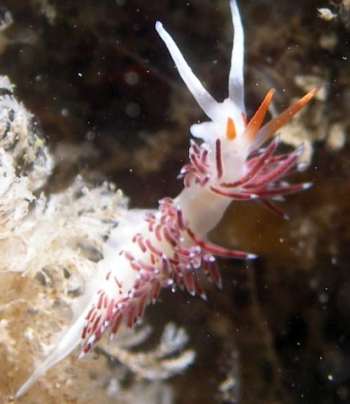
Cratena capensis
Barnard, 1927
Order: NUDIBRANCHIA
Suborder: AEOLIDINA
Family: Glaucidae
DISTRIBUTION
Common in Cape Province, South Africa. Apparently endemic to the region (Gosliner, 1987).
PHOTO
Haerlem Wreck, Algoa Bay, Port Elizabeth, South Africa, Indian Ocean. 18 m. 06-Aug-2005, 10 mm. wreck superstructure. Photo: Charles Rowe
The body is translucent white and the long oral tentacles and rhinophores have varing amounts of opaque white speckling which can in some cases covers all but the basal region. The specimen illustrated has orange on the rhinophores which has not previously been recorded. Specimens usually have some brown speckling on the oral tentacles, rhinophores, and dorsal midline, but this can be absent (MacNae, 1954). There are a pair of elongate orange patches on the head, one in front of each rhinophore. The ceratal wall is transparent, sometimes with white speckling. The ceratal tip is white, and the ceratal digeative gland ranges in colour from red to dark brown depending on which of the variety of hydroids it is reported to feed on, it has been eating. This species is distinctive in having short blunt anterior foot corners. The precardiac cerata are arranged in an arch and the postcadiac cerata are in single rows. It grows to at least 30 mm in length.
-
Barnard, K. H. (1927) South African nudibranch mollusca, with descriptions of new species, and a note on some specimens from Tristan d'Acunha. Annals of the South African Museum, 25: 171-215, Pls19, 20.
-
Gosliner, T. M. (1987) Nudibranchs of Southern Africa, a guide to the Opisthobranchs of southern Africa. Monterey, Sea Challengers. 1-136.
-
Macnae, W. (1954) On some eolidacean nudibranchiate molluscs from South Africa. Annals of the Natal Museum, 13: 1-50, Pls1-2.
Rudman, W.B., 2005 (September 20) Cratena capensis Barnard, 1927. [In] Sea Slug Forum. Australian Museum, Sydney. Available from http://www.seaslugforum.net/factsheet/cratcape
Related messages
-
Cratena capensis from Algoa Bay, South Africa
From: Charles Rowe, September 20, 2005
